calsfoundation@cals.org
Leachville (Mississippi County)
| Latitude and Longitude: | 35°56’09″N 090°15’28″W |
| Elevation: | 237 feet |
| Area: | 4.40 square miles (2020 Census) |
| Population: | 2,039 (2020 Census) |
| Incorporation Date: | February 2, 1916 |
Historical Population as per the U.S. Census:
|
1810 |
1820 |
1830 |
1840 |
1850 |
1860 |
1870 |
1880 |
1890 |
1900 |
|
– |
– |
– |
– |
– |
– |
– |
– |
– |
– |
|
1910 |
1920 |
1930 |
1940 |
1950 |
1960 |
1970 |
1980 |
1990 |
2000 |
|
– |
– |
1,157 |
1,076 |
1,230 |
1,507 |
1,582 |
1,882 |
1,743 |
1,981 |
|
2010 |
2020 |
|
|
|
|
|
|
|
|
|
1,993 |
2,039 |
Leachville of Mississippi County was once known as “The Cleanest Town on Buffalo Island, Where Agriculture and Industry Meet.” Established about 1896, Leachville is thirty miles east of Jonesboro (Craighead County) and twenty-eight miles west of Blytheville (Mississippi County). Leachville’s founding fathers were James Wiseman Honnoll, Joshua Gilbert Leach, and Sam McNamee of Holly Springs, Mississippi. Leach and Honnoll incorporated the Leach-McNamee Land Development Company on March 15, 1898. Honnoll named the town in honor of Leach. Although founded in 1896, the town was not incorporated until February 2, 1916.
The Gilded Age through Early Twentieth Century
The late nineteenth century brought business and industry to the settlement. In 1898, the Cannon family, which had moved to Leachville early on, started a sawmill. Products from the mill were transported to Arbyrd, Missouri, for shipment. Honnoll used lumber from the mill to build the first official place of worship, the First United Methodist Church. It is the oldest structure in the city limits.
In 1899, the railroad came to Leachville. The first to arrive was the Jonesboro, Lake City and Eastern Railroad. The Blytheville, Leachville and Arkansas Southern Railroad (BL&AS) was incorporated on April 25, 1908. The railroad was a significant industry in the town for many years. The BL&AS depot at 2nd & McNamee is now privately owned and was placed on the National Register of Historic Places in June 1992.
Electricity was introduced in 1924. The first paved roads appeared in 1925. Water was piped into town in 1935, although the first sewer systems did not arrive until 1942. Telephones were routed to the area in the 1930s. Many rural residents remained on “party lines” until the 1970s, when private lines were extended beyond the city limits.
During the late nineteenth century, Leachville faced many of the same issues as other predominantly white small towns in Arkansas, with its segregated bathrooms, water fountains, and restaurants.
World War II through the Faubus Era
In 1956, residents raised $100,000 and provided a tract of land as a pledge for Brown Shoe Company to build a factory. This was the sustaining industry for the next twenty-seven years. At its peak, it employed more than 500 residents of the Leachville area. Brown Shoe Factory closed in July 1983. This closing devastated the community, and, according to Mayor Ralph Wells, the town’s economic status never fully recovered. Several companies, including a furniture company and a home fashions manufacturer, tried to replace Brown Shoe in the original building, but they eventually closed. The building began housing a satellite branch of a local plastics manufacturer, employing ten to twelve people.
Education
Records indicate that the first graduating class of Leachville High School was in 1927, with only four students. The original three-story school building was destroyed by fire in 1937. The earliest photos still available today date back only to 1919. The existing building on the south side of the campus was constructed in 1938, after the fire, along with the agriculture building. The old elementary school was built in 1944. In 1953, the gymnasium burned, and the new gym near the existing elementary school was constructed. The public schools of Leachville and neighboring Monette (Craighead County) consolidated to form the Buffalo Island Central (BIC) school district in May 1984. Each town maintains its own elementary schools, which are now known as BIC East and BIC West. Junior high students began attending class in Leachville, and senior high students went to Monette. After the consolidation, a new gymnasium was built in Monette. The Buffalo Island Central (BIC) high school basketball team, known as the “Mustangs,” is highly ranked in local and state tournament play.
Modern Era
As in many small towns in Arkansas, cotton farms are an important asset to Leachville. In 1992, the Adams Land Company cotton gin was built at the north end of town. Owned and operated by Bo and Myrna Adams, it is the largest cotton gin in Arkansas. Along with the Sanders Seed & Fertilizer Company next to the gin, it is considered to be the sustaining industry of Leachville.
Attractions include the sprawling Adams Estate just east of Leachville on Arkansas 77. With its magnificent ponds, sculptures, and gardens, it is the largest single-family residence in town and employs many Leachville residents. For several years, the estate hosted an annual holiday light show, which brought many visitors. Proceeds were donated to local charities. The light show was then moved to the former Eaker Air Force Base in Blytheville.
The Melody Theatre showed movies until 1978. Residents in the twenty-first century enjoy live music shows in the historic building, including gospel, country, and rock.
In 1955, Elvis Presley visited Leachville while on his way to Texas. He performed a three-song concert on January 20, 1955, sponsored by the senior class and held at the gymnasium. He performed: “That’s All Right,” “Hearts of Stone,” and “Tweedle Dee.”
Though the majority of residents are white, Hispanic residency has increased significantly in the modern era, effecting a cultural change.
Current businesses include two banks, three restaurants (including a Mexican cafe), a drugstore, four gas stations, a furniture store, an auto parts store, beauty salons, seven churches, and a branch of Blytheville’s Arkansas Northeastern College. Howard Funeral Service was established in Leachville in 1917 and is the oldest business in town still in operation. Medical needs are met by a Main Street clinic, a vital asset to the farming industry and the Leachville community as a whole, since the city of Leachville is located thirty miles from the nearest hospital.
The rejuvenated city park is behind the elementary school and offers baseball fields, tennis courts, a walking track, barbecue grills, picnic tables, and playground equipment.
The city government is maintained by a small group, including the mayor, a city clerk/recorder, aldermen, three police officers, and a police chief. City Hall is a modest building on Main Street next to the library and the police station. It also houses the water company and a courtroom where local cases are tried.
Leachville attracted international attention when, on December 10, 2021, a deadly tornado struck the town, damaging or destroying numerous buildings, including the local Dollar General store, by then the only place selling groceries in Leachville. The tornado was part of a larger storm system that affected several states.
For additional information:
Ellis, Dale. “Survivors Weigh Storm’s Toil.” Arkansas Democrat-Gazette, December 13, 2021, pp. 1A, 8A. Online at https://www.arkansasonline.com/news/2021/dec/13/northeast-arkansas-tornado-victims-recall-storms/ (accessed June 18, 2022).
Erdington, Mable F. History of Mississippi County, Arkansas. Ocala, FL: Ocala Star-Banner, 1962.
“First United Methodist Church of Leachville: Founded Thanksgiving Day, 1898, Centennial Celebration November 8, 1998.” Leachville, AR: First United Methodist Church, 1998.
History of Leachville, Arkansas in the Bicentennial Year. Leachville, AR: Leachville Jaycees, 1976.
Leachville, Arkansas, Vertical File. Craighead County Public Library, Jonesboro, Arkansas.
Steed, Stephen. “State Farmers Take Tornado Hit.” Arkansas Democrat-Gazette, December 14, 2021, pp. 1D, 2D. Online at https://www.arkansasonline.com/news/2021/dec/14/state-farmers-take-tornado-hit/ (accessed June 18, 2022).
Vrbin, Tess. “Storms Rip State; Deaths Put at 2.” Arkansas Democrat-Gazette, December 12, 2021, pp. 1A, 10A. Online at https://www.arkansasonline.com/news/2021/dec/12/it-felt-like-it-was-burying-us-northeast-arkansas/ (accessed June 18, 2022).
Terry Thomas
Arkansas State University
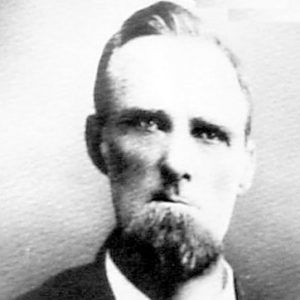 J. W. Honnoll
J. W. Honnoll 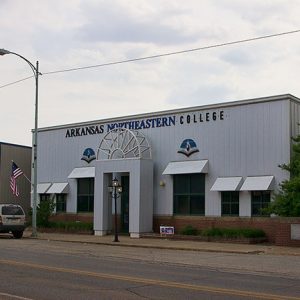 Leachville Campus
Leachville Campus 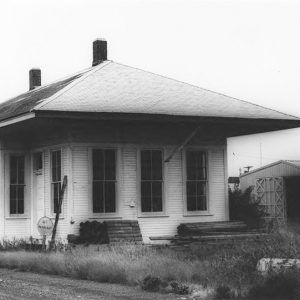 Leachville Depot
Leachville Depot 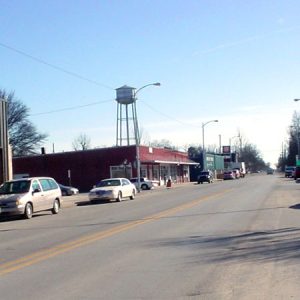 Leachville Street Scene
Leachville Street Scene 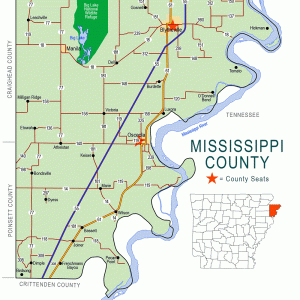 Mississippi County Map
Mississippi County Map 



I was born here in Leachville; my family has lived in Leachville now for four generations. My grandfather, Ephram Monroe Howard, was the engineer on the BL&AS Railroad (belonging to the Chicago Mill and Lumber Company based in Blytheville), which was the logging train that cleared this land in Leachville and on Buffalo Island. (I have a wonderful clear picture of that train and the workers on it in 1913 or 1914.) My grandfather lived in Blytheville at the time he was working as the engineer, but he settled in Leachville during that time with his wife and children and started a business in 1917. Howard Funeral Service is the very oldest business in this town and has been owned by our family for four generations. The funeral home has been here on call for Leachville twenty-four hours a day, 360 days a year, since 1917. We also ran an ambulance service, the only one from 1917 until about 1970. When the government put too many regulations on ambulances and funeral homes, we basically had to drop the ambulance service business but did not want to.